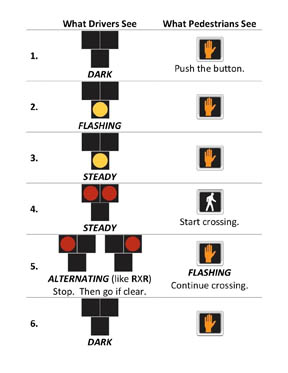Montgomery County Executive Isiah Leggett announced the completion of pedestrian improvements on Hewitt Avenue in Silver Spring that will enhance safety for transit users and the entire community. The innovative pedestrian protection improvements installed have successfully been used by the MCDOT in other locations and have proven to be effective in reducing motorist speeds, calming traffic and enhancing safety.
Following a request from a resident, MCDOT's Division of Traffic Engineering and Operations installed three pedestrian refuge islands (an area between lanes of traffic where pedestrians may safely wait) along the nearly one-mile stretch of Hewitt Avenue between Georgia Avenue and Blue Spruce Lane. The refuge islands not only help calm traffic, but also reduce the crossing distance for pedestrians. The improvement project narrowed the travel lanes on the roadway to reduce vehicle speeds. MCDOT also installed marked crosswalks, “State Law: Stop for Pedestrians” signs, lane markings and raised pavement markers. In addition, staff modified the parking restrictions on Hewitt around the refuge islands and adjusted bus stop locations.
MCDOT analyzed traffic along Hewitt Avenue. The speed limit is 30 mph. A review of the crash data for five years between 2004 and 2008 revealed a total of 35 non-intersection related crashes. Of these, two involved pedestrians.
For more information about the County’s Pedestrian Safety program, go to MCDOT's pedestrian safety website or call 240-777-7155.
Wednesday, November 10, 2010
Pedestrian Safety Improvements on Hewitt Avenue
Sunday, October 31, 2010
Pedestrian Safety Program County Council Review

The MCDOT Director and staff, with the Montgomery County Police Department, presented an overview of the County’s Pedestrian Safety Program to the County Council back in October 2010. This Pedestrian Safety Program Review was requested by Council as an update on the progress of the County Executive’s Pedestrian Safety Initiative.
Labels:
education,
engineering,
intersections,
program overview,
safety audits,
signals,
traffic calming
Sunday, September 5, 2010
Work Planned for Piney Branch HIA
MCDOT has announced its plan of action for the Piney Branch High Incident Area. Click on the image below to review this plan. For questions, contact Community Outreach at 240.777.7155.
 |
Wednesday, September 1, 2010
Department of Transportation Testing New Pedestrian-Oriented Traffic Signal on Gude Drive in Rockville
Montgomery County’s Department of Transportation’s (MCDOT) Traffic Engineering Division is testing a new type of pedestrian-oriented traffic signal on Gude Drive in Rockville in an area that has had eight pedestrian collisions in the past two years.

HAWK stands for High-intensity Activated crossWalK signal.
This new signal uses traditional traffic and pedestrian signal heads but in a different configuration

How it works: When not activated, the signal is dark, allowing drivers to freely pass through. It is activated when a pedestrian pushes the walk button. The HAWK signal begins flashing yellow to indicate to drivers someone will be using the crosswalk. It then goes to solid yellow like a typical traffic signal, advising drivers to prepare to stop. The signal then turns solid red, requiring drivers to stop at the crosswalk. Finally, the signal goes to flashing red, letting drivers know that after coming to a complete stop, they can proceed once the pedestrian has crossed safely. The signal then returns to the dark condition.
Wednesday, August 18, 2010
Pedestrian Safety Featured at MACo Convention

Jeff Dunckel and Tom Pogue of MCDOT staffed the Montgomery County display at the Maryland Association of Counties (MACo) Convention in Ocean City, Maryland last August. More than 600 attendees visited the display to learn how Montgomery County is improving pedestrian safety. This year, County Executive Leggett chose the County's Pedestrian Safety Program as the featured topic for Montgomery County to highlight. This annual conference draws thousands of local, state and federal government officials.
Tuesday, March 23, 2010
Street Smart 2010 Kick-off Makes Big Impact

Street Smart kicked off its 2010 Safety Awareness Campaign on Thursday, March 23, with a “Speed Kills” Demonstration. This very successful event was held at the intersection of Sligo Avenue and Chicago Avenue, in Silver Spring, Maryland. The demonstration graphically displayed how speeding eliminates the ability of drivers to avoid pedestrian collisions -- how driving the speed limit can save lives. The key message to be remembered from the demonstration is: Speed Kills -- obeying speed limits is a life-or-death obligation for all drivers. The consequences if you don’t can be truly horrific. To see a video displaying this demonstration, go to the website: BeStreetSmart.net.
This 2010 Safety Awareness Campaign will continue through April, 2010. See Campaign Background Materials:
- Press Conference Agenda
- Press Release
- Regional Traffic Fatalities 1998-2008
- Montgomery County Traffic Fatalities 2004-2009
- Regional Pedestrian Safety Fact Sheet
- Speed and Stopping Distance Demonstration Facts











Remember - Speed Kills. Slow Down.
Obey Speed Limits. Stay Alert.
BE STREET SMART!
Subscribe to:
Comments (Atom)
